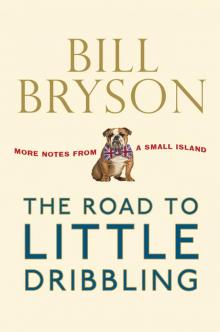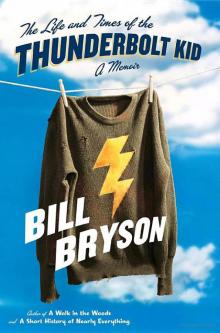- Home
- Bill Bryson
The Road to Little Dribbling Page 26
The Road to Little Dribbling Read online
Page 26
At Skegness, I had read, they have preserved one of the original 1936 chalets, so that people can appreciate how far the camps have come, and I was eager to see it. So I set off along the sodden front in the direction of Butlin’s, and walked for quite a distance, but I didn’t encounter anything but a lot of rain and duney spaciousness. I stopped a youth on a bike and asked him how far it was to Butlin’s. ‘Oh, miles,’ he said, and kept going. Butlin’s Skegness, it turns out, is not in Skegness at all, but in Ingoldmells, nearly four miles away up the A52. I peered into the murk through glasses that were like windows in a steam room and decided that I would try again in the morning.
Soaked, I returned to my room to change into dry clothes. Out of idle curiosity, I looked up some figures on the internet from VisitEngland, as the English Tourist Board has restyled itself in the evident belief that if you fuse two words in a title it makes you look stylish and forward thinking instead of just slightly desperate and in need of new management, and these were frankly astounding to me. Skegness, it turns out, receives 537,000 visitors a year, making it the ninth most visited place in Britain. Among seaside resorts, only Scarborough and Blackpool are more popular. Measured by spending, visitors to Skegness spent more than visitors to Bath, Birmingham or Newcastle upon Tyne. Perhaps they come for the colonic hydrotherapy. Who could possibly say?
When enough time had mercifully passed to consider it the evening, I went to a large, popular, characterless pub for a pint before dinner, then dined in a quiet Indian restaurant called the Gandhi. The food was fine, but the Gandhi didn’t seem to be doing a lot of business. Reluctant to return early to my lonely room, I dawdled over my jalfrezi and drank one giant bottle of Cobra beer too many, which left me ruminative but in good spirits. At the door, I spent quite some time stabbing unsuccessfully at the right armhole of my jacket, until a young employee stepped up and kindly sorted me out.
‘Thank you,’ I said, then shared with him a sudden idea that I thought might perk up the place. ‘You should make this into an Elvis-themed restaurant,’ I said. ‘You could call it Love Me Tandoor.’
Leaving him with that thought, I toddled off, just a touch unsteadily, into the night.
II
In the morning, I drove north to Ingoldmells and found Butlin’s. It wasn’t hard as it was an enormous compound that looked like a prison camp. Lethal-looking fencing with lacerating tops surrounded the entire camp and gave every appearance that it was trying to keep people in at least as much as it was trying to keep the rest of us out. The front entrance had barriers and a security booth. I told the security man that I just wanted to look at the original chalet, but he said, and seemed genuinely regretful, that he couldn’t let me in. I would have to buy a day ticket to the camp when the office opened, but that wasn’t for another two hours. A day ticket would cost £20. We agreed that that was a lot of money just to look at an eighty-year-old chalet, and on that note we parted.
I should say that I had thought already of booking into the camp as a staying guest, but the idea of a man on his own hanging around in a Butlin’s watching people seemed a little bit creepy, even to me. What if I was challenged or, worse, recognized? Come to that, what if I was mugged by feral children? The consequences hardly bore thinking about. (‘Bryson was taken into custody after he was seen giving sweets to children by the helter-skelter.’) So, disappointed, I returned to the car and headed north to Grimsby.
Grimsby in the early twentieth century was the largest fishing port in the world. Not in Britain, not in northern Europe, but in the world. I have seen photographs of giant stacks of ling, a large codlike fish that once abounded in British waters, piled higher than a man’s head on the Grimsby dockside. Each ling was about six feet long. No fisherman alive today has seen a ling that big. In 1950, Grimsby’s fleet brought in 1,100 tonnes of ling. Today the annual haul is eight tonnes. And ling was only ever a small part of the overall catch. Cod, halibut, haddock, skate, wolf fish and other species most of us have never heard of were heaped on the docks in staggering, but unsustainable, volumes. In a generation, beam trawlers scraped the seabed bare, turning much of the North Sea floor into a marine desert. In 1950, Grimsby landed over 100,000 tonnes of cod. Today it brings in under 300. Altogether Grimsby’s annual wetfish catch has fallen from nearly 200,000 tonnes to just 658 tonnes – and even those paltry numbers, according to the York University oceanographer Callum Roberts, are more than the denuded North Sea can sustain. In a riveting book called Ocean of Life, Roberts notes that every year the fisheries ministers of Europe agree quotas that are on average one third higher than the levels recommended by their own scientists.
But compared with much of the rest of the world, Europe is a beacon of enlightenment. Among the many amazing and depressing facts in his book, Roberts gives a list of all the aquatic life incidentally killed – the by-catch, as it is known – by a fishing boat in the Pacific Ocean in the process of legally catching just 211 mahi-mahi. Among the aquatic animals hauled aboard and tossed back dead after a single sweep were:
488 turtles
455 stingrays and devil rays
460 sharks
68 sailfish
34 marlin
32 tuna
11 wahoo
8 swordfish
4 giant sunfish
This was legal under international protocols. The hooks on the longlines were certified as ‘turtle friendly’. All this was to give 211 people a dinner of mahi-mahi.
Grimsby was not at all what I expected. I had imagined it to be a compact city, at its heart a network of narrow lanes, built around a stone-walled harbour, like a Cornish fishing village but on a somewhat grander scale. In fact Grimsby’s port was huge and far removed from the town. The town centre wasn’t compact and charming and townlike, but grubbily urban, with busy roads that were difficult to cross on foot. Between the centre of town and the port was a soulless zone of box stores, none of which seemed to be doing terribly well. The chain-link fence of a Homebase bore a strangely festive banner announcing that it was closing down imminently. Several other businesses were gone, their perimeters ankle deep or worse in blown litter and fly-tipping. I passed the police station, which had a rather nice lawn out front, but it was strewn with beer cans and other detritus. What kind of community is it where people can throw litter on the lawn of a police station with impunity? What kind of police force doesn’t tidy up its own grounds?
There were a few nice places here and there. John Pettit and Sons, an old-fashioned butcher’s on Bethlehem Street, which has been there since 1892, according to its sign, was busy with loyal customers and looked splendid. I wish it every success. I was also rather taken with a hairdresser’s called Curl Up and Dye. But that pretty well summarizes the high spots of Grimsby.
Victoria Mills, an enormous brick heap, a former flour mill, loomed above the box stores. It is a fantastic building. Move it to Battersea and it would be full of stylish apartments. Here it seemed largely derelict. Later I learned that half the building has been converted into apartments – very nice ones, too, it seems – but the other, forlorn half was owned by a company that had repeatedly failed orders to carry out conservation work. According to the Grimsby Telegraph it had been fined £5,000 in the local magistrates’ court in June 2013 for failing to do the work. The company didn’t represent itself at the hearing. A fair-sized shrub could be seen growing out of a window eight floors up. This did not give the appearance of a building that was loved and cared for.
Nearby, on a stretch of quayside overlooking the broad River Freshney, was a large, rather stylish building called the Fishing Heritage Centre. This turned out to be a museum, which was delightful and fascinating and about much more than just fishing. On the ground floor were several recreated interiors, including those of a local pub and a fish and chip shop as they were in the twenties or thirties. I was particularly interested to note that people in Grimsby used to bring their own fish and have the shop fry it for a penny. The best display of all w
as one showing what the interior of a ship’s galley was like in rough seas. The display was built on a steep slant so that everything was caught in a frozen moment of slopping. This was everything a museum should be – fun, imaginative, thoroughly absorbing, wonderfully instructive.
Elsewhere there was lots of interesting stuff about fish and fishing – that a single turbot can produce 14 million eggs, for instance. I know that sounds a trifle dull out of context, but three of us reading the label simultaneously made an appreciative, slightly camp ‘Oooh’ sound, like Kenneth Williams in a Carry On movie, and meant it sincerely. Everywhere the displays were thoughtful, intelligent, and carefully spelled and punctuated. Someone needs to go and get the Natural History Museum people in London and bring them here. Then they need to leave them here and take the Grimsby museum people back with them.
In the gift shop, I spent some time looking at a fascinating book called Grimsby: The Story of the World’s Greatest Fishing Port, which surveyed the rise and tragic fall of this once-great place. Grimsby’s problems, I learned, were mostly self-inflicted. While fishermen cleared the seas of almost everything that swam or rested on the sandy bottom, the town fathers were tearing down nearly all of Grimsby’s finest buildings and monuments. Doughty Park cemetery was swept away, as were all the town’s theatres and good hotels, and many of its best houses, too. The Corn Exchange, a nineteenth-century market cross that looked rather like a prototype rocket ship, was first turned into a public lavatory, as a kind of preliminary insult, then demolished altogether. It was as if Grimsby was trying to obliterate every reminder that it had ever known greatness. It succeeded. You have to conclude that Grimsby today is about what it deserves to be.
And with that gloomy thought to mull over, I collected my car and drove on to a very much nicer place: elsewhere.
Chapter 19
The Peak District
I
FOR YEARS when I was growing up, I often walked on Sunday afternoons to the Ingersoll movie theatre, a mile or so from my home in Des Moines, and took in a matinee. It was a single-screen cinema (they nearly all were then) and I watched whatever was showing. The Ingersoll clearly didn’t get the first pick of pictures because mostly it showed small, little-noted movies, often European. Frequently I was one of just two or three people in the audience. The result of this is that I have seen, and can often still fondly recall, movies that I suspect even their stars have forgotten: Woman of Straw with Sean Connery and Gina Lollobrigida; the chilling Unman, Wittering and Zigo with David Hemmings; Laughter in the Dark with Nicol Williamson and the sultry Anna Karina. How we could have done with a few like her at Roosevelt High School, I used to think.
I enjoyed these movies often as much for their locations as for their plots – the sooty buildings of London, the mad traffic of Rome, the sunny villas and twisting corniches of the Mediterranean – and of none was this more true than a slow but lustrous feature called The Virgin and the Gypsy, based on the D. H. Lawrence novella and starring Joanna Shimkus and Franco Nero. It was a languorous piece of work, with lots of moody shots across moorland. In one scene, a camera panned across an enormous stone dam and reservoir, which stood in a silent landscape of wooded hills and heath. The dam was made of great blocks of stone and rose like a mountain from the green water. At each end it had a decorative castellated tower. It was, at the very least, intensely picturesque, and I couldn’t understand why it wasn’t better known. It would be famous in Iowa, believe me. When the movie finished, I walked home and never thought another thing about it.
Thirty years later, while walking in the Peak District with my friends Andrew and John, we came down a wooded slope at a place called Howden Moor and there before me, abruptly filling my view, was the castellated dam from the movie. I recognized it at once. It was a little smaller than I would have expected, but otherwise was just as splendid, just as commanding and beautiful, as I remembered it. It’s called the Derwent Reservoir and it was built in the early years of the twentieth century to supply water to Sheffield, Derby, Chesterfield and the other old industrial towns that border the Peak District. I understand now, having lived in Britain for a long time, why it isn’t better known. Britain is packed so solid with good stuff – with castles, stately homes, hill forts, stone circles, medieval churches, giant figures carved in hillsides, you name it – that a good deal of it gets lost. It is a permanent astonishment to me how casually strewn with glory Britain is. If the Derwent dam were in Iowa, it would be on the state’s licence plates. There would be campgrounds, an RV park, probably an outlet centre. Here it is anonymous and forgotten, a momentary diversion on a countryside amble.
Let me take just a moment to say some numbers. Britain has 450,000 listed buildings, 20,000 scheduled ancient monuments, twenty-six World Heritage Sites, 1,624 registered parks and gardens (that is, gardens and parks of historic significance), 600,000 known archaeological sites (and more being found every day; more being lost, too), 3,500 historic cemeteries, 70,000 war memorials, 4,000 sites of special scientific interest, 18,500 medieval churches, and 2,500 museums containing 170 million objects. Having such a fund of richness means that it can sometimes be taken for granted to a shocking degree, but it also means that very often you can find you have something quite wonderful pretty much to yourself, as I did with Derwent Reservoir now.
It is managed by Severn Trent Water, a utility, which provides a little visitors’ centre with a tea counter and a car park, but the car park was mostly empty when I arrived. A lovely walk goes around the lake, and connects with two nearby reservoirs, Howden and Ladybower, both also very fetching.
Derwent Reservoir is notable for one other thing. It was here that they practised for the famous dam-busters raids of the Second World War when the British engineer Barnes Wallis invented his celebrated bouncing bombs. These were designed to skip across water, like a stone across a pond, until they hit the dam, when they would explode with, all being well, devastating consequences. In practice, the scheme didn’t really work. The low-flying planes were easy targets for German gunners – 40 per cent of the squadron didn’t return from the first mission – and many bombs exploded harmlessly in the water or bounced straight over the dam walls and detonated in neighbouring fields. Only one dam was seriously breached; the floodwaters from it killed about 1,700 people, but these were mostly Allied prisoners, so that in fact Barnes Wallis killed more people on his own side than on the German one. But never mind. It was one of those feats of wartime ingenuity that could be set alongside radar and the Enigma machine as evincing Britain’s indomitable spirit and cleverness. In 1955, the bouncing bombs story was made into a film much beloved by the people who programme daytime movies on BBC Two. I don’t believe I have ever had the flu without watching Dam Busters at some point.
I had a good walk along the Derwent and Howden reservoirs, enjoying the combination of shady woodland and sun-splashed water, amazed that I could have this much splendour to myself. On the way back to the car park, I passed an impressive stone monument. It was to a sheepdog named Tip, which, according to the inscription, ‘stayed by the body of his dead master, Mr Joseph Tagg, on the Howden Moors for fifteen weeks’. That’s a very long time. Mind you, Tagg was lying on the dog’s lead. Actually, I don’t know what the story was, but I do know that personally I would be more inclined to pay for a monument that said, ‘In memory of Tip, who went for help when I needed it.’
It was interesting, I thought, that the memorial to Tip was grander than the memorial to the men who took part in the dam-busters raids, but then I remembered that this was England and Tip was a dog.
A few miles west of the Derwent Valley is Kinder Scout, highest point in the Peak District at a little under 2,100 feet. Kinder Scout was the site of a celebrated act of civil disobedience in 1932 when workers from nearby factory towns defiantly walked across the Duke of Devonshire’s grouse moors. Their actions that day had much to do with the opening of the countryside to walkers, so I thought I would pay my respects as I was
in the neighbourhood. I parked in the pretty village of Hayfield and walked the mile or so to the trespass site at Bowden Bridge and was glad I had. Along the way I passed a terraced cottage with a blue plaque on it noting that this was the birthplace of the great character actor Arthur Lowe – Captain Mainwaring in Dad’s Army. And there you have a perfect demonstration of the merits of foot travel over motorized travel, for if I had driven I would never have noticed the plaque, thus proving that a walker’s life is not only healthier but richer.
Kinder Scout isn’t a peak but a grassy plateau, frequently visible from Manchester and Sheffield. That was the root of the problem, it seems. Workers in Manchester and Sheffield gazed dreamily upon it from their gritty neighbourhoods and thought of it as their hill, the place where they could go for fresh air and spiritual refreshment at weekends, and for years they did. But in the 1920s the Duke of Devonshire closed Kinder Scout to the public for the sake of his grouse shooting. This naturally bred resentment, and in April 1932 five hundred people, mostly factory workers, gathered at Bowden Bridge to undertake a protest walk across the duke’s land.
Tipped off about the hike, the duke’s gamekeepers were waiting and ordered the hikers to turn back. The result was a brief and rather endearingly ineffectual scuffle. One gamekeeper was knocked unconscious, probably accidentally, but there were no other injuries and the walkers completed their march to the summit. The authorities, overreacting, arrested the group’s leaders and charged them with criminal trespass. Five men were sent to prison for up to five months – an outrageously disproportionate punishment. The result was a wave of anger and resentment that went well beyond Derbyshire. The Mass Trespass (as it is now invariably written) became an iconic moment in the history of both class struggle and the British countryside. In other countries they fight over politics and religion. In Britain, it is over who gets to walk on a windswept moor. I think that’s rather splendid.

 Notes from a Small Island
Notes from a Small Island A Short History of Nearly Everything
A Short History of Nearly Everything A Walk in the Woods
A Walk in the Woods I'm a Stranger Here Myself
I'm a Stranger Here Myself The Mother Tongue
The Mother Tongue Shakespeare
Shakespeare A Short History of Nearly Everything: Special Illustrated Edition
A Short History of Nearly Everything: Special Illustrated Edition The Best American Travel Writing 2016
The Best American Travel Writing 2016 The Road to Little Dribbling
The Road to Little Dribbling The Life And Times Of The Thunderbolt Kid: A Memoir (v5.0)
The Life And Times Of The Thunderbolt Kid: A Memoir (v5.0) Made In America
Made In America Seeing Further
Seeing Further Shakespeare: The World as Stage
Shakespeare: The World as Stage The Life and Times of the Thunderbolt Kid
The Life and Times of the Thunderbolt Kid At Home
At Home Bryson's Dictionary For Writers And Editors (v5.0)
Bryson's Dictionary For Writers And Editors (v5.0) Neither Here Nor There
Neither Here Nor There Bill Bryson's African Diary
Bill Bryson's African Diary